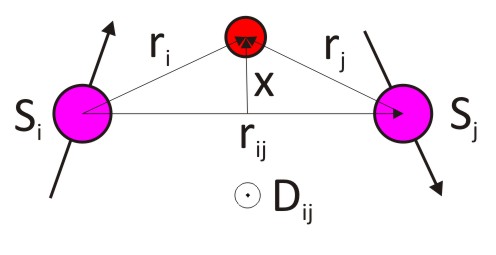Unconventional antiferromagnetism due to Dzyaloshinskii-Moriya interactions
The relevance of antisymmetric superexchange interactions in spin Hamiltonians describing quantum antiferromagnetic (AF) systems has been acknowledged long ago by Dzyaloshinskii. Soon after, Moriya showed that such interactions arise naturally in perturbation theory due to the spin-orbit coupling in magnetic systems with low symmetry. Nowadays, a number of AF systems are known to belong to the class of Dzyaloshinskii-Moriya (DM) magnets, such as ?-Fe2O3, LaMnO3 and K2V3O8, and to exhibit unusual and interesting magnetic properties in the presence of quantum fluctuations and/or applied magnetic field.

Also belonging to the class of DM antiferromagnets is La2CuO4 (LCO), which is a parent compound of high-temperature superconductors. In LCO the DM interaction arises from the orthorhombic distortion of the oxygen octahedra around each copper ion. Such a distortion and the layered structure of the compound give rise to a peculiar magnetic structure, where the Cu++ spins are canted out of the CuO2 layers with opposite canting directions between neighboring layers. Due to the smallness of the DM coupling D with respect to the Heisenberg superexchange J (D/J=0.01),the out-of-plane ferromagnetic moments are very small. Nonetheless, their effects on the physical properties can be huge, because in practice they generate a coupling between the staggered order parameter and the uniform magnetic field, which is unexpected in a conventional antiferromagnet. For example, when a small magnetic field is applied perpendicular to the layers the magnetic susceptibility shows a strong enhancement as the Neèl temperature is approached, due to the formation of these ferromagnetic moments.
The unconventional properties of LCO have been measured by means of different probes, ranging from spin-susceptibility measurements, neutron scattering and single-magnon raman scattering. An elegant and powerfull description of these effects can be achieved by using a modified non-linear sigma model field approach [1], where the DM interaction mediates a coupling between the magnetic field and the staggered order parameter, absent in ordinary AF systems (as for example Sr2CuO2Cl2). The theoretical calculations display an excellent agreement with the experiments. The same approach can be extended at finite but small doping [2], in the regime where holes are trapped by the donors and frustrate the antiferromagnetic background without destroying completely long-range order.
[1] L. Benfatto, and M. B. Silva Neto,
Field dependence of the magnetic spectrum in anisotropic and Dzyaloshinskii-Moriya antiferromagnets: I. Theory,
Phys. Rev. B 74, 024415 (2006).
[2] M. B. Silva Neto and L. Benfatto,
Impurity susceptibility and the fate of spin-flop transitions in lightly-doped La(2)CuO(4),
Phys. Rev. B 75, 140501(R) (2007).


